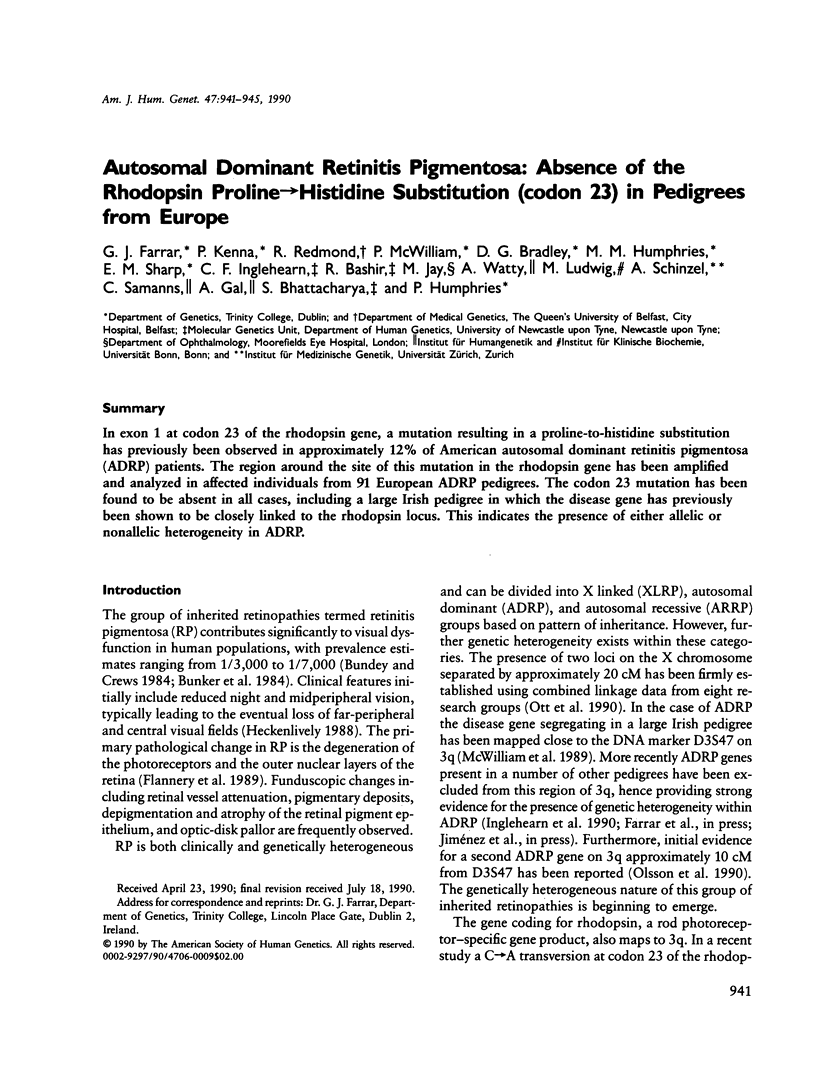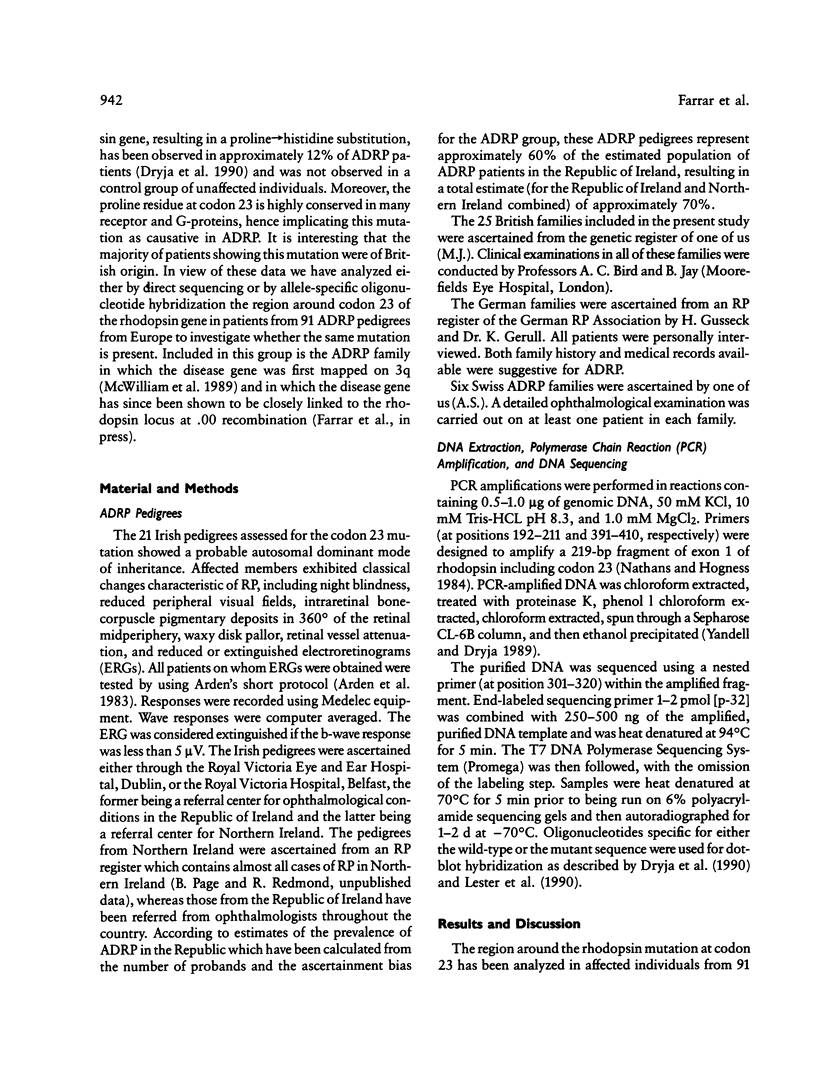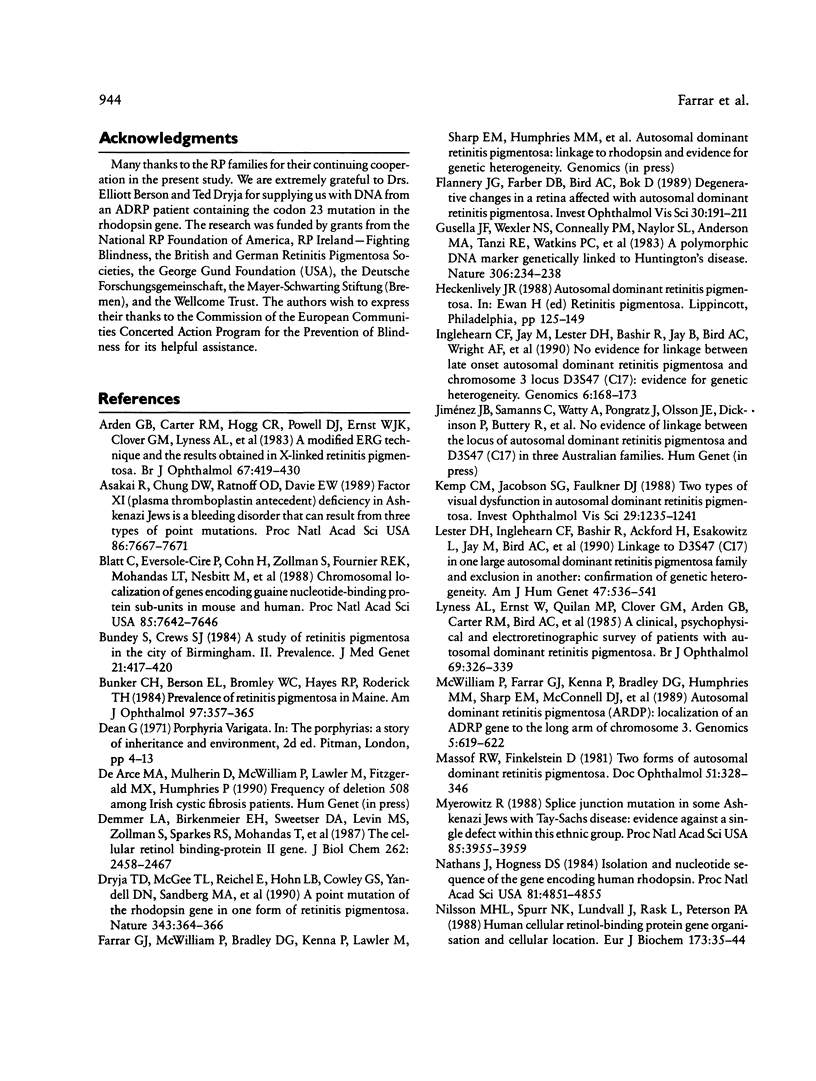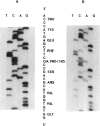Abstract
In exon 1 at codon 23 of the rhodopsin gene, a mutation resulting in a proline-to-histidine substitution has previously been observed in approximately 12% of American autosomal dominant retinitis pigmentosa (ADRP) patients. The region around the site of this mutation in the rhodopsin gene has been amplified and analyzed in affected individuals from 91 European ADRP pedigrees. The codon 23 mutation has been found to be absent in all cases, including a large Irish pedigree in which the disease gene has previously been shown to be closely linked to the rhodopsin locus. This indicates the presence of either allelic or nonallelic heterogeneity in ADRP.
Full text
PDF




Images in this article
Selected References
These references are in PubMed. This may not be the complete list of references from this article.
- Arden G. B., Carter R. M., Hogg C. R., Powell D. J., Ernst W. J., Clover G. M., Lyness A. L., Quinlan M. P. A modified ERG technique and the results obtained in X-linked retinitis pigmentosa. Br J Ophthalmol. 1983 Jul;67(7):419–430. doi: 10.1136/bjo.67.7.419. [DOI] [PMC free article] [PubMed] [Google Scholar]
- Asakai R., Chung D. W., Ratnoff O. D., Davie E. W. Factor XI (plasma thromboplastin antecedent) deficiency in Ashkenazi Jews is a bleeding disorder that can result from three types of point mutations. Proc Natl Acad Sci U S A. 1989 Oct;86(20):7667–7671. doi: 10.1073/pnas.86.20.7667. [DOI] [PMC free article] [PubMed] [Google Scholar]
- Blatt C., Eversole-Cire P., Cohn V. H., Zollman S., Fournier R. E., Mohandas L. T., Nesbitt M., Lugo T., Jones D. T., Reed R. R. Chromosomal localization of genes encoding guanine nucleotide-binding protein subunits in mouse and human. Proc Natl Acad Sci U S A. 1988 Oct;85(20):7642–7646. doi: 10.1073/pnas.85.20.7642. [DOI] [PMC free article] [PubMed] [Google Scholar]
- Bundey S., Crews S. J. A study of retinitis pigmentosa in the City of Birmingham. I Prevalence. J Med Genet. 1984 Dec;21(6):417–420. doi: 10.1136/jmg.21.6.417. [DOI] [PMC free article] [PubMed] [Google Scholar]
- Bunker C. H., Berson E. L., Bromley W. C., Hayes R. P., Roderick T. H. Prevalence of retinitis pigmentosa in Maine. Am J Ophthalmol. 1984 Mar;97(3):357–365. doi: 10.1016/0002-9394(84)90636-6. [DOI] [PubMed] [Google Scholar]
- Demmer L. A., Birkenmeier E. H., Sweetser D. A., Levin M. S., Zollman S., Sparkes R. S., Mohandas T., Lusis A. J., Gordon J. I. The cellular retinol binding protein II gene. Sequence analysis of the rat gene, chromosomal localization in mice and humans, and documentation of its close linkage to the cellular retinol binding protein gene. J Biol Chem. 1987 Feb 25;262(6):2458–2467. [PubMed] [Google Scholar]
- Dryja T. P., McGee T. L., Reichel E., Hahn L. B., Cowley G. S., Yandell D. W., Sandberg M. A., Berson E. L. A point mutation of the rhodopsin gene in one form of retinitis pigmentosa. Nature. 1990 Jan 25;343(6256):364–366. doi: 10.1038/343364a0. [DOI] [PubMed] [Google Scholar]
- Flannery J. G., Farber D. B., Bird A. C., Bok D. Degenerative changes in a retina affected with autosomal dominant retinitis pigmentosa. Invest Ophthalmol Vis Sci. 1989 Feb;30(2):191–211. [PubMed] [Google Scholar]
- Gusella J. F., Wexler N. S., Conneally P. M., Naylor S. L., Anderson M. A., Tanzi R. E., Watkins P. C., Ottina K., Wallace M. R., Sakaguchi A. Y. A polymorphic DNA marker genetically linked to Huntington's disease. Nature. 1983 Nov 17;306(5940):234–238. doi: 10.1038/306234a0. [DOI] [PubMed] [Google Scholar]
- Inglehearn C. F., Jay M., Lester D. H., Bashir R., Jay B., Bird A. C., Wright A. F., Evans H. J., Papiha S. S., Bhattacharya S. S. No evidence for linkage between late onset autosomal dominant retinitis pigmentosa and chromosome 3 locus D3S47 (C17): evidence for genetic heterogeneity. Genomics. 1990 Jan;6(1):168–173. doi: 10.1016/0888-7543(90)90462-4. [DOI] [PubMed] [Google Scholar]
- Kemp C. M., Jacobson S. G., Faulkner D. J. Two types of visual dysfunction in autosomal dominant retinitis pigmentosa. Invest Ophthalmol Vis Sci. 1988 Aug;29(8):1235–1241. [PubMed] [Google Scholar]
- Lester D. H., Inglehearn C. F., Bashir R., Ackford H., Esakowitz L., Jay M., Bird A. C., Wright A. F., Papiha S. S., Bhattacharya S. S. Linkage to D3S47 (C17) in one large autosomal dominant retinitis pigmentosa family and exclusion in another: confirmation of genetic heterogeneity. Am J Hum Genet. 1990 Sep;47(3):536–541. [PMC free article] [PubMed] [Google Scholar]
- Lyness A. L., Ernst W., Quinlan M. P., Clover G. M., Arden G. B., Carter R. M., Bird A. C., Parker J. A. A clinical, psychophysical, and electroretinographic survey of patients with autosomal dominant retinitis pigmentosa. Br J Ophthalmol. 1985 May;69(5):326–339. doi: 10.1136/bjo.69.5.326. [DOI] [PMC free article] [PubMed] [Google Scholar]
- Massof R. W., Finkelstein D. Two forms of autosomal dominant primary retinitis pigmentosa. Doc Ophthalmol. 1981 Nov;51(4):289–346. doi: 10.1007/BF00143336. [DOI] [PubMed] [Google Scholar]
- McWilliam P., Farrar G. J., Kenna P., Bradley D. G., Humphries M. M., Sharp E. M., McConnell D. J., Lawler M., Sheils D., Ryan C. Autosomal dominant retinitis pigmentosa (ADRP): localization of an ADRP gene to the long arm of chromosome 3. Genomics. 1989 Oct;5(3):619–622. doi: 10.1016/0888-7543(89)90031-1. [DOI] [PubMed] [Google Scholar]
- Myerowitz R. Splice junction mutation in some Ashkenazi Jews with Tay-Sachs disease: evidence against a single defect within this ethnic group. Proc Natl Acad Sci U S A. 1988 Jun;85(11):3955–3959. doi: 10.1073/pnas.85.11.3955. [DOI] [PMC free article] [PubMed] [Google Scholar]
- Nathans J., Hogness D. S. Isolation and nucleotide sequence of the gene encoding human rhodopsin. Proc Natl Acad Sci U S A. 1984 Aug;81(15):4851–4855. doi: 10.1073/pnas.81.15.4851. [DOI] [PMC free article] [PubMed] [Google Scholar]
- Nilsson M. H., Spurr N. K., Lundvall J., Rask L., Peterson P. A. Human cellular retinol-binding protein gene organization and chromosomal location. Eur J Biochem. 1988 Apr 5;173(1):35–44. doi: 10.1111/j.1432-1033.1988.tb13963.x. [DOI] [PubMed] [Google Scholar]
- Olsson J. E., Samanns C., Jimenez J., Pongratz J., Chand A., Watty A., Seuchter S. A., Denton M., Gal A. Gene of type II autosomal dominant retinitis pigmentosa maps on the long arm of chromosome 3. Am J Med Genet. 1990 Apr;35(4):595–599. doi: 10.1002/ajmg.1320350434. [DOI] [PubMed] [Google Scholar]
- Ott J., Bhattacharya S., Chen J. D., Denton M. J., Donald J., Dubay C., Farrar G. J., Fishman G. A., Frey D., Gal A. Localizing multiple X chromosome-linked retinitis pigmentosa loci using multilocus homogeneity tests. Proc Natl Acad Sci U S A. 1990 Jan;87(2):701–704. doi: 10.1073/pnas.87.2.701. [DOI] [PMC free article] [PubMed] [Google Scholar]
- Yandell D. W., Dryja T. P. Detection of DNA sequence polymorphisms by enzymatic amplification and direct genomic sequencing. Am J Hum Genet. 1989 Oct;45(4):547–555. [PMC free article] [PubMed] [Google Scholar]



